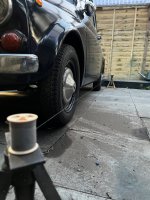turbo500
Member
- Joined
- Mar 20, 2013
- Messages
- 251
- Points
- 118
I finally got around to replacing all the joints up front however I noticed that the the toe was pointing out.
I was in a hurry so I ended up getting it as straight as I could but the track rods are definitely not even on both sides.
Maybe I’m being a little thick, but can I make them equal without removing the tie Rod ends from the sockets? Or do I need to remove everything to get them measured?
I’m getting confused with the fact that I can spin the Rod but it looked as if it wasn’t found anything in terms of steering angle…
I was in a hurry so I ended up getting it as straight as I could but the track rods are definitely not even on both sides.
Maybe I’m being a little thick, but can I make them equal without removing the tie Rod ends from the sockets? Or do I need to remove everything to get them measured?
I’m getting confused with the fact that I can spin the Rod but it looked as if it wasn’t found anything in terms of steering angle…


